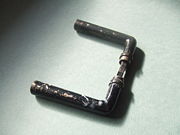
Ferdinand Kramer
Encyclopedia



Architect
An architect is a person trained in the planning, design and oversight of the construction of buildings. To practice architecture means to offer or render services in connection with the design and construction of a building, or group of buildings and the space within the site surrounding the...
and functionalist
Functionalism (architecture)
Functionalism, in architecture, is the principle that architects should design a building based on the purpose of that building. This statement is less self-evident than it first appears, and is a matter of confusion and controversy within the profession, particularly in regard to modern...
designer.
Kramer's father was owner of the most well-known of Frankfurt hat shops. In 1916, immediately after conclusion of school, Kramer was drawn in to military service and remained a soldier through the end of the First World War. The following year he trained at the Bauhaus
Bauhaus
', commonly known simply as Bauhaus, was a school in Germany that combined crafts and the fine arts, and was famous for the approach to design that it publicized and taught. It operated from 1919 to 1933. At that time the German term stood for "School of Building".The Bauhaus school was founded by...
for a few months before quitting, disillusioned with the technical level of the training, then began a three-year architectural study in Munich
Munich
Munich The city's motto is "" . Before 2006, it was "Weltstadt mit Herz" . Its native name, , is derived from the Old High German Munichen, meaning "by the monks' place". The city's name derives from the monks of the Benedictine order who founded the city; hence the monk depicted on the city's coat...
with Theodor Fischer
Theodor Fischer
Theodor Fischer was a German architect and teacher.Fischer planned public housing projects for the city of Munich beginning in 1893. He was the joint founder and first chairman of the Deutscher Werkbund , as well as member of the German version of the Garden city movement...
. Kramer returned to Frankfurt in 1922. With the lack of architectural commissions during this period of inflation, he concentrated on furniture designs for Thonet
Michael Thonet
Michael Thonet was a German-Austrian cabinet maker.Thonet was the son of master tanner Franz Anton Thonet of Boppard. Following a carpenter's apprenticeship, Thonet set himself up as an independent cabinetmaker in 1819. A year later, he married Anna Grahs, with whom he had seven sons and six...
and metal utensils, for example his "Kramer Oven", a sheet-metal furnace.
From 1925 through 1930 Kramer worked for architect and civic planner Ernst May
Ernst May
Ernst May was a German architect and city planner.May successfully applied urban design techniques to the city of Frankfurt am Main during Germany's Weimar period, and in 1930 less successfully exported those ideas to Soviet Union cities, newly created under Stalinist rule...
building and furnishing the housing projects of New Frankfurt, and was a contributor to the second CIAM
CIAM
CIAM may refer to:* Commission Internationale Aeromodelling, a section of Fédération Aéronautique Internationale* Congrès International d'Architecture Moderne, the International Congress of Modern Architecture...
conference. After disputes with the Nazi regime and professional disqualification, Kramer emigrated to the United States in 1938 and worked on a variety of projects, including work with Norman bel Geddes
Norman Bel Geddes
Norman Melancton Bel Geddes was an American theatrical and industrial designer who focused on aerodynamics....
on designs for the New York World's Fair of 1939, designs for inexpensive "knock-down" furniture which anticipate today's commercial "flat-pack" furniture, and commissions from his friend Theodor Adorno for the Institute for Social Research
Institute for Social Research
The Institute for Social Research is a research organization for sociology and continental philosophy, best known as the institutional home of the Frankfurt School and critical theory....
during its New York years. Kramer became a naturalized US citizen in 1945.
On his return to Germany in 1947, Kramer taught and served as the director of building at the Johann Wolfgang Goethe University of Frankfurt am Main
Johann Wolfgang Goethe University of Frankfurt am Main
The Goethe University Frankfurt was founded in 1914 as a Citizens' University, which means that, while it was a State university of Prussia, it had been founded and financed by the wealthy and active liberal citizenry of Frankfurt am Main, a unique feature in German university history...
until his retirement into private practice in 1964. He was married to Beate Kramer and later to Lore Kramer, who still cares for his legacy. They have three daughters called Barbara, Anna and Katharina
The university moves step by step to the new Poelzig/Westend and Nieder-Eschbach campuses, so many of the old buildings in Bockenheim will be sold or even torn down.
The heritage
From December 9, 1982 to January 23, 1983 a retrospective of Kramer's work was shown at Bauhaus archive in Berlin.From June 5 to August 4, 1991 the Museum for Design in Zurich (Switzerland) showed another retrospective "Ferdinand Kramer - Der Charme des Systematischen" which was also shown in Frankfurt at the Deutscher Werkbund (in cooperation with the DAM, Deutsches Architektur Museum) and later at the Bauhaus Dessau.
The Frankfurt university keeps samples of furniture designed especially for their purposes (as part of their heritage) in the archives. A few other museums like the Museum für Angewandte Kunst in Frankfurt am Main, the Design collection in Wuppertal or the Thonet Museum as well as the Vitra Museum have several older pieces of Kramer's furnitures. Some products designed by Kramer are re-issued, like the doorhandle (by ironmonger / in Germany by Tecnoline).

